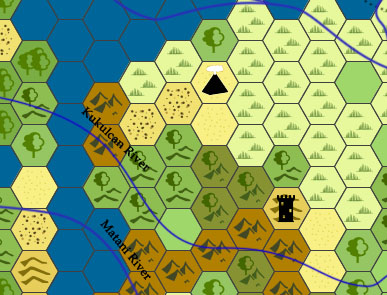I agree with the general sentiment here that in a densely populated region, settlements should be around 5 miles apart, with double that for a frontier region. With those guidelines, a 30 by 30 mile starter region on the frontier would have a city, two or three towns, and a half dozen or more villages. Throw in 6 or 8 ruins and dungeons, and several monster settlements, and you have more than enough scope to take a campaign to mid levels.
The campaign I'm currently working on is situated on a 30 x 20 hex map, with 5 miles to the hex - so 150 x 100 miles. A third of the map is frontier, the rest is wilderness. I'm mapping the settled area around the starting locale at 1 mile to the hex. The location of the epic, campaign-capping showdown is 120 miles (6 days one way on horseback) from the starting settlement. That's more than enough space to run an entire campaign.
Of course, published D&D adventures get density spectacularly - almost comically - wrong. A 30 by 30 mile map in a campaign published by WotC or Paizo will typically have one town and a couple villages spaced much further than 10 miles apart, with great stretches of nothing between them. I blame the influence of Tolkien (people forget Middle Earth was supposed to be a haunted wasteland), and the fact D&D started in the American Midwest, where settlements conform to train and car travel times, not walking.
RPG publishers have also cited 25 miles per day foot travel rates, taken from the marching rate of U.S. soldiers in training - distances achieved on paved roads with modern footwear, packs, and clothing. No account taken of bad roads or cart paths, mud and streams, or the need to forage for water, fodder, and firewood. Not to mention hauling armour and heavy iron weapons, coping with recalcitrant pack mules, and the constant need to be wary of ambush.
The campaign I'm currently working on is situated on a 30 x 20 hex map, with 5 miles to the hex - so 150 x 100 miles. A third of the map is frontier, the rest is wilderness. I'm mapping the settled area around the starting locale at 1 mile to the hex. The location of the epic, campaign-capping showdown is 120 miles (6 days one way on horseback) from the starting settlement. That's more than enough space to run an entire campaign.
Of course, published D&D adventures get density spectacularly - almost comically - wrong. A 30 by 30 mile map in a campaign published by WotC or Paizo will typically have one town and a couple villages spaced much further than 10 miles apart, with great stretches of nothing between them. I blame the influence of Tolkien (people forget Middle Earth was supposed to be a haunted wasteland), and the fact D&D started in the American Midwest, where settlements conform to train and car travel times, not walking.
RPG publishers have also cited 25 miles per day foot travel rates, taken from the marching rate of U.S. soldiers in training - distances achieved on paved roads with modern footwear, packs, and clothing. No account taken of bad roads or cart paths, mud and streams, or the need to forage for water, fodder, and firewood. Not to mention hauling armour and heavy iron weapons, coping with recalcitrant pack mules, and the constant need to be wary of ambush.




